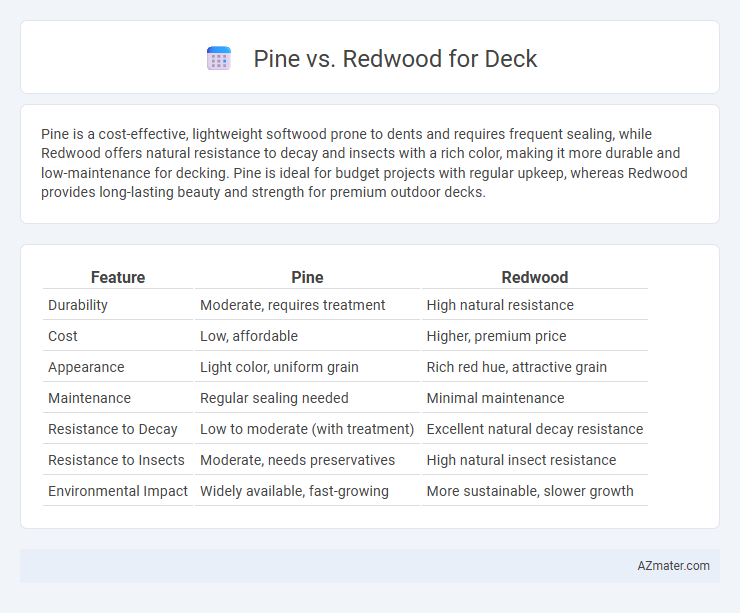Pine is a cost-effective, lightweight softwood prone to dents and requires frequent sealing, while Redwood offers natural resistance to decay and insects with a rich color, making it more durable and low-maintenance for decking. Pine is ideal for budget projects with regular upkeep, whereas Redwood provides long-lasting beauty and strength for premium outdoor decks.
Table of Comparison
| Feature | Pine | Redwood |
|---|---|---|
| Durability | Moderate, requires treatment | High natural resistance |
| Cost | Low, affordable | Higher, premium price |
| Appearance | Light color, uniform grain | Rich red hue, attractive grain |
| Maintenance | Regular sealing needed | Minimal maintenance |
| Resistance to Decay | Low to moderate (with treatment) | Excellent natural decay resistance |
| Resistance to Insects | Moderate, needs preservatives | High natural insect resistance |
| Environmental Impact | Widely available, fast-growing | More sustainable, slower growth |
Introduction to Pine and Redwood for Decking
Pine and redwood are popular wood choices for decking due to their durability and aesthetic appeal. Pine, a softwood, is often treated with preservatives to resist decay and insect damage, making it affordable and widely available. Redwood, a naturally resistant softwood with rich reddish hues, offers superior rot resistance and a luxurious finish, enhancing outdoor spaces with its natural beauty.
Physical Characteristics: Pine vs Redwood
Pine decking features a lighter color with a fine, straight grain and a softer texture, making it prone to dents and scratches but easy to work with. Redwood displays a rich reddish hue, with a natural resistance to decay and insects due to its dense, tight grain and oils. Both woods vary in durability; redwood offers superior stability and resistance while pine requires treatment to enhance its lifespan.
Durability and Lifespan Comparison
Redwood offers superior durability compared to pine due to its natural resistance to decay, insects, and moisture, making it an excellent choice for long-lasting decks. Pine, especially pressure-treated varieties, is more affordable but generally requires regular maintenance to protect against rot and insect damage, which can shorten its lifespan. On average, a redwood deck can last 20 to 30 years with minimal upkeep, while a pine deck typically lasts 10 to 15 years depending on treatment and maintenance frequency.
Maintenance Requirements of Each Wood
Pine decks require regular sealing and staining every 1-2 years to prevent moisture damage and warping, making maintenance more frequent compared to Redwood. Redwood naturally resists decay and insects due to its high tannin content, reducing the need for frequent treatments and extending its lifespan with minimal upkeep. Both woods benefit from periodic cleaning to remove dirt and prevent mold growth, but Redwood's inherent durability significantly lowers overall maintenance efforts.
Cost Analysis: Pine vs Redwood
Pine decks typically cost between $15 and $25 per square foot, making them a more budget-friendly option compared to redwood, which ranges from $25 to $35 per square foot due to its premium quality and natural resistance to decay. Maintenance costs for pine can be higher over time because it requires regular sealing and treatment to prevent rot and insect damage, whereas redwood's inherent durability reduces long-term upkeep expenses. Considering initial investment and lifecycle costs, pine is suitable for cost-conscious projects, while redwood offers better value in terms of longevity and lower maintenance.
Environmental Impact and Sustainability
Pine decks offer a renewable resource due to fast growth rates and widespread availability, resulting in lower carbon footprints compared to slow-growing redwood. Redwood, harvested primarily from old-growth forests, raises sustainability concerns but can be sourced from certified sustainable forests to mitigate environmental impact. Choosing FSC-certified pine or sustainably managed redwood ensures reduced deforestation and promotes responsible forestry practices.
Appearance and Aesthetic Appeal
Pine decks offer a light, warm tone with a fine, consistent grain that can be easily stained or painted to match various design styles, providing a versatile aesthetic appeal. Redwood features a rich, natural reddish hue and prominent grain patterns that create a striking, rustic look, often prized for its deep color and classic elegance. Both woods enhance outdoor spaces with distinct visual qualities, but redwood is typically favored for its luxurious, eye-catching appearance while pine is chosen for customizable finishes and affordability.
Weather and Pest Resistance
Redwood offers superior natural resistance to moisture, insects, and decay, making it an ideal choice for decks exposed to harsh weather conditions and pest-prone areas. Pine, especially pressure-treated varieties, can withstand weather and pests but generally requires more frequent maintenance and treatments to maintain durability. Redwood's high tannin content provides long-lasting protection, reducing the need for chemical preservatives compared to standard pine lumber.
Installation Considerations
Pine offers easier installation due to its lightweight nature and uniform texture, making it ideal for beginner-friendly deck building. Redwood requires pre-drilling to prevent splitting because of its dense grain, which adds time and effort during installation. Proper fastening with corrosion-resistant screws is crucial for both woods to ensure long-lasting deck stability.
Which Wood is Best for Your Deck?
Pine and redwood are popular choices for decking, but redwood offers superior durability and natural resistance to decay, making it ideal for outdoor use in various climates. Pine is more affordable and widely available but requires proper treatment and regular maintenance to withstand moisture and insect damage. For a low-maintenance, long-lasting deck with natural beauty, redwood is best, while pine suits budget-conscious projects with ongoing care.

Infographic: Pine vs Redwood for Deck
 azmater.com
azmater.com